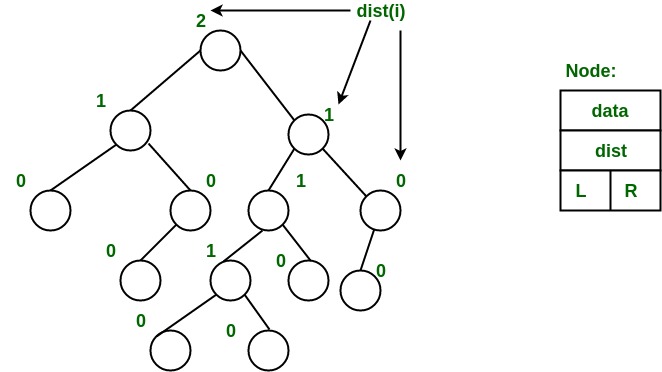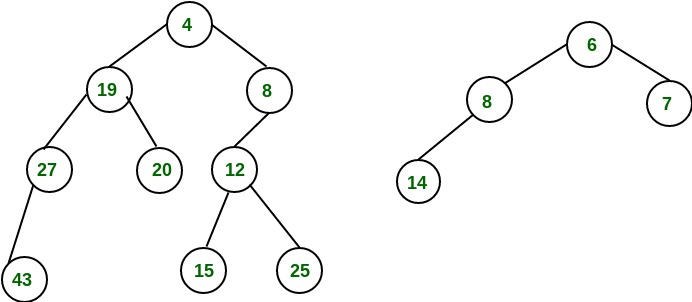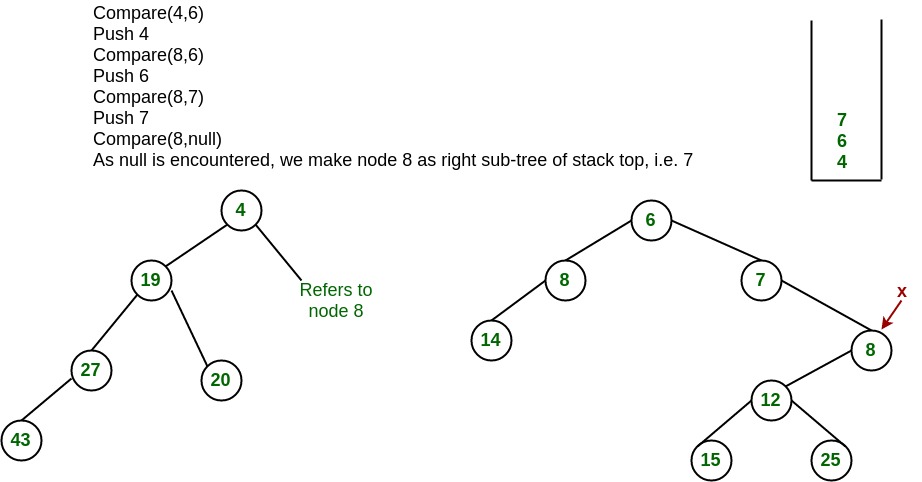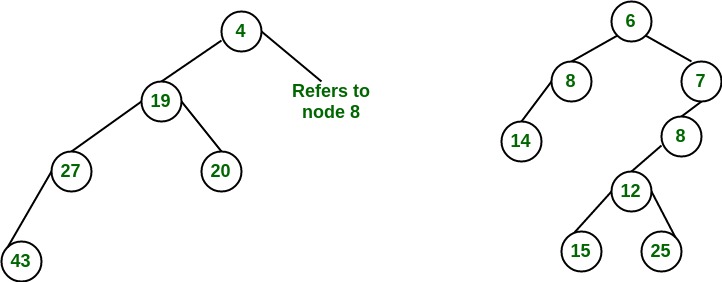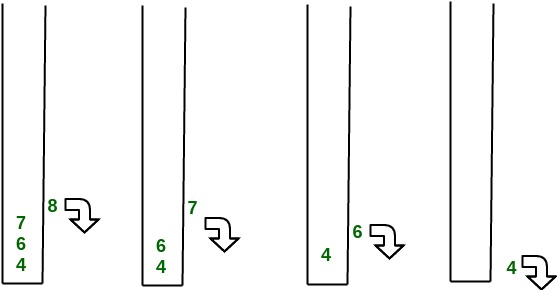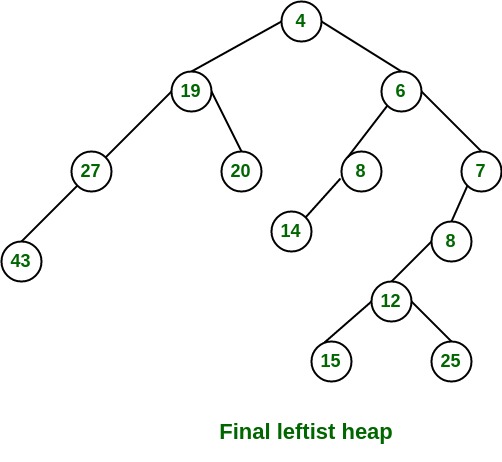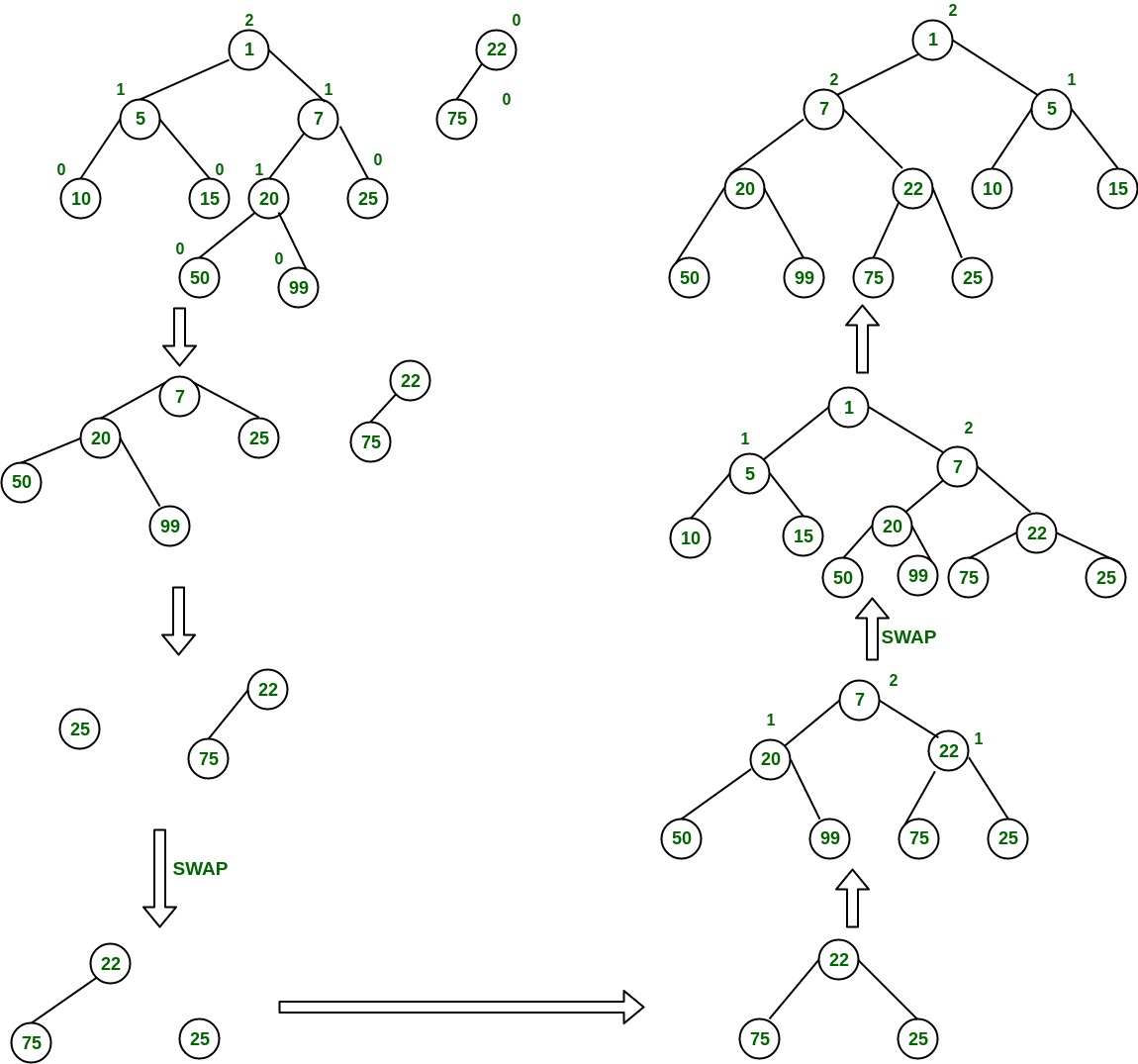Applications of K-ary Heap:
- K-ary heap when used in the implementation of priority queue allows faster decrease key operation as compared to binary heap (
- Nevertheless, it causes the complexity of extractMin() operation to increase to
- This allows K-ary heap to be more efficient in algorithms where decrease priority operations are more common than extractMin() operation.
- Example: Dijkstra’s algorithm for single source shortest path and Prim’s algorithm for minimum spanning tree
- K-ary heap has better memory cache behaviour than a binary heap which allows them to run more quickly in practice, although it has a larger worst case running time of both extractMin() and delete() operation (both being
Implementation:
Assuming 0 based indexing of array, an array represents a K-ary heap such that for any node we consider:
- Parent of the node at index i (except root node) is located at index
- Children of the node at index i are at indices
- The last non-leaf node of a heap of size n is located at index
buildHeap() : Builds a heap from an input array.
This function runs a loop starting from the last non-leaf node all the way upto the root node, calling a function restoreDown(also known as maHeapify) for each index that restores the passed index at the correct position of the heap by shifting the node down in the K-ary heap building it in a bottom up manner.
Why do we start the loop from the last non-leaf node ?
Because all the nodes after that are leaf nodes which will trivially satisfy the heap property as they don’t have any children and hence, are already roots of a K-ary max heap.
restoreDown() (or maxHeapify) : Used to maintain heap property.
It runs a loop where it finds the maximum of all the node’s children, compares it with its own value and swaps if the max(value of all children) > (value at node). It repeats this step until the node is restored into its original position in the heap.
extractMax() : Extracting the root node.
A k-ary max heap stores the largest element in its root. It returns the root node, copies last node to the first, calls restore down on the first node thus maintaining the heap property.
insert() : Inserting a node into the heap
This can be achieved by inserting the node at the last position and calling restoreUp() on the given index to restore the node at its proper position in the heap. restoreUp() iteratively compares a given node with its parent, since in a max heap the parent is always greater than or equal to its children nodes, the node is swapped with its parent only when its key is greater than the parent.
K-Arr Heap in C++
// C++ program to demonstrate all operations of
// k-ary Heap
#include<bits/stdc++.h>
using namespace std;
// function to heapify (or restore the max- heap
// property). This is used to build a k-ary heap
// and in extractMin()
// att[] -- Array that stores heap
// len -- Size of array
// index -- index of element to be restored
// (or heapified)
void restoreDown(int arr[], int len, int index,
int k)
{
// child array to store indexes of all
// the children of given node
int child[k+1];
while (1)
{
// child[i]=-1 if the node is a leaf
// children (no children)
for (int i=1; i<=k; i++)
child[i] = ((k*index + i) < len) ?
(k*index + i) : -1;
// max_child stores the maximum child and
// max_child_index holds its index
int max_child = -1, max_child_index ;
// loop to find the maximum of all
// the children of a given node
for (int i=1; i<=k; i++)
{
if (child[i] != -1 &&
arr[child[i]] > max_child)
{
max_child_index = child[i];
max_child = arr[child[i]];
}
}
// leaf node
if (max_child == -1)
break;
// swap only if the key of max_child_index
// is greater than the key of node
if (arr[index] < arr[max_child_index])
swap(arr[index], arr[max_child_index]);
index = max_child_index;
}
}
// Restores a given node up in the heap. This is used
// in decreaseKey() and insert()
void restoreUp(int arr[], int index, int k)
{
// parent stores the index of the parent variable
// of the node
int parent = (index-1)/k;
// Loop should only run till root node in case the
// element inserted is the maximum restore up will
// send it to the root node
while (parent>=0)
{
if (arr[index] > arr[parent])
{
swap(arr[index], arr[parent]);
index = parent;
parent = (index -1)/k;
}
// node has been restored at the correct position
else
break;
}
}
// Function to build a heap of arr[0..n-1] and value of k.
void buildHeap(int arr[], int n, int k)
{
// Heapify all internal nodes starting from last
// non-leaf node all the way upto the root node
// and calling restore down on each
for (int i= (n-1)/k; i>=0; i--)
restoreDown(arr, n, i, k);
}
// Function to insert a value in a heap. Parameters are
// the array, size of heap, value k and the element to
// be inserted
void insert(int arr[], int* n, int k, int elem)
{
// Put the new element in the last position
arr[*n] = elem;
// Increase heap size by 1
*n = *n+1;
// Call restoreUp on the last index
restoreUp(arr, *n-1, k);
}
// Function that returns the key of root node of
// the heap and then restores the heap property
// of the remaining nodes
int extractMax(int arr[], int* n, int k)
{
// Stores the key of root node to be returned
int max = arr[0];
// Copy the last node's key to the root node
arr[0] = arr[*n-1];
// Decrease heap size by 1
*n = *n-1;
// Call restoreDown on the root node to restore
// it to the correct position in the heap
restoreDown(arr, *n, 0, k);
return max;
}
// Driver program
int main()
{
const int capacity = 100;
int arr[capacity] = {4, 5, 6, 7, 8, 9, 10};
int n = 7;
int k = 3;
buildHeap(arr, n, k);
printf("Built Heap : \n");
for (int i=0; i<n; i++)
printf("%d ", arr[i]);
int element = 3;
insert(arr, &n, k, element);
printf("\n\nHeap after insertion of %d: \n",
element);
for (int i=0; i<n; i++)
printf("%d ", arr[i]);
printf("\n\nExtracted max is %d",
extractMax(arr, &n, k));
printf("\n\nHeap after extract max: \n");
for (int i=0; i<n; i++)
printf("%d ", arr[i]);
return 0;
}
Output
Built Heap :
10 9 6 7 8 4 5
Heap after insertion of 3:
10 9 6 7 8 4 5 3
Extracted max is 10
Heap after extract max:
9 8 6 7 3 4 5
### K-Arr Heap Time Complexity Analysis
- For a k-ary heap, with n nodes the maximum height of the given heap will be logkn. So restoreUp() run for maximum of logkn times (as at every iteration the node is shifted one level up is case of restoreUp() or one level down in case of restoreDown).
- restoreDown() calls itself recursively for k children. So time complexity of this functions is O(k logkn).
- Insert and decreaseKey() operations call restoreUp() once. So complexity is O(logkn).
- Since extractMax() calls restoreDown() once, its complexity O(k logkn)
- Time complexity of build heap is O(n) (Analysis is similar to binary heap)
Leftist Heap
Leftist Tree / Leftist Heap
A leftist tree or leftist heap is a priority queue implemented with a variant of a binary heap. Every node has an s-value (or rank or distance) which is the distance to the nearest leaf. In contrast to a binary heap (Which is always a complete binary tree), a leftist tree may be very unbalanced. Below are time complexities of Leftist Tree / Heap.
Leftist Tree / Leftist Heap
| Function | Complexity | Comparison |
|---|---|---|
| Get Min | O(1) | same as both Binary and Binomial |
| Delete Min | O(Log n) | same as both Binary and Binomial |
| Insert | O(Log n) | O(Log n) in Binary and O(1) in Binomial and O(Log n) for worst case |
| Merge | O(Log n) | O(Log n) in Binomial |
Leftist Tree / Leftist Heap
A leftist tree is a binary tree with properties:
- Normal Min Heap Property : key(i) >= key(parent(i))
- Heavier on left side : dist(right(i)) <= dist(left(i)). Here, dist(i) is the number of edges on the shortest path from node i to a leaf node in extended binary tree representation (In this representation, a null child is considered as external or leaf node). The shortest path to a descendant external node is through the right child. Every subtree is also a leftist tree and dist( i ) = 1 + dist( right( i ) ).
Leftist Tree / Leftist Heap Example
-
The below leftist tree is presented with its distance calculated for each node with the procedure mentioned above.
-
The rightmost node has a rank of 0 as the right subtree of this node is null and
-
its parent has a distance of 1 by dist( i ) = 1 + dist( right( i )).
-
The same is followed for each node and their s-value( or rank) is calculated.
From above second property, we can draw two conclusions :
- The path from root to rightmost leaf is the shortest path from root to a leaf.
- If the path to rightmost leaf has x nodes, then leftist heap has atleast 2x – 1 nodes. This means the length of path to rightmost leaf is O(log n) for a leftist heap with n nodes.
Leftist Tree / Leftist Heap Operations
- The main operation is merge().
- deleteMin() (or extractMin() can be done by removing root and calling merge() for left and right subtrees.
- insert() can be done be create a leftist tree with single key (key to be inserted) and calling merge() for given tree and tree with single node.
Leftist Tree / Leftist Heap Operations
Idea behind Merging : Since right subtree is smaller, the idea is to merge right subtree of a tree with other tree. Below are abstract steps.
- Put the root with smaller value as the new root.
- Hang its left subtree on the left.
- Recursively merge its right subtree and the other tree.
- Before returning from recursion: – Update dist() of merged root. – Swap left and right subtrees just below root, if needed, to keep leftist property of merged result
Leftist Tree / Leftist Heap Operations
Detailed Steps for Merge:
- Compare the roots of two heaps.
- Push the smaller key into an empty stack, and move to the right child of smaller key.
- Recursively compare two keys and go on pushing the smaller key onto the stack and move to its right child.
- Repeat until a null node is reached.
- Take the last node processed and make it the right child of the node at top of the stack, and convert it to leftist heap if the properties of leftist heap are violated.
- Recursively go on popping the elements from the stack and making them the right child of new stack top.
Example: Consider two leftist heaps given below:
The subtree at node 7 violates the property of leftist heap so we swap it with the left child and retain the property of leftist heap.
Convert to leftist heap. Repeat the process
The worst case time complexity of this algorithm is O(log n) in the worst case, where n is the number of nodes in the leftist heap. Another example of merging two leftist heap:
Leftist Tree / Leftist Heap in C++
//C++ program for leftist heap / leftist tree
#include <bits/stdc++.h>
using namespace std;
// Node Class Declaration
class LeftistNode
{
public:
int element;
LeftistNode *left;
LeftistNode *right;
int dist;
LeftistNode(int & element, LeftistNode *lt = NULL,
LeftistNode *rt = NULL, int np = 0)
{
this->element = element;
right = rt;
left = lt,
dist = np;
}
};
//Class Declaration
class LeftistHeap
{
public:
LeftistHeap();
LeftistHeap(LeftistHeap &rhs);
~LeftistHeap();
bool isEmpty();
bool isFull();
int &findMin();
void Insert(int &x);
void deleteMin();
void deleteMin(int &minItem);
void makeEmpty();
void Merge(LeftistHeap &rhs);
LeftistHeap & operator =(LeftistHeap &rhs);
private:
LeftistNode *root;
LeftistNode *Merge(LeftistNode *h1,
LeftistNode *h2);
LeftistNode *Merge1(LeftistNode *h1,
LeftistNode *h2);
void swapChildren(LeftistNode * t);
void reclaimMemory(LeftistNode * t);
LeftistNode *clone(LeftistNode *t);
};
// Construct the leftist heap
LeftistHeap::LeftistHeap()
{
root = NULL;
}
// Copy constructor.
LeftistHeap::LeftistHeap(LeftistHeap &rhs)
{
root = NULL;
*this = rhs;
}
// Destruct the leftist heap
LeftistHeap::~LeftistHeap()
{
makeEmpty( );
}
/* Merge rhs into the priority queue.
rhs becomes empty. rhs must be different
from this.*/
void LeftistHeap::Merge(LeftistHeap &rhs)
{
if (this == &rhs)
return;
root = Merge(root, rhs.root);
rhs.root = NULL;
}
/* Internal method to merge two roots.
Deals with deviant cases and calls recursive Merge1.*/
LeftistNode *LeftistHeap::Merge(LeftistNode * h1,
LeftistNode * h2)
{
if (h1 == NULL)
return h2;
if (h2 == NULL)
return h1;
if (h1->element < h2->element)
return Merge1(h1, h2);
else
return Merge1(h2, h1);
}
/* Internal method to merge two roots.
Assumes trees are not empty, and h1's root contains
smallest item.*/
LeftistNode *LeftistHeap::Merge1(LeftistNode * h1,
LeftistNode * h2)
{
if (h1->left == NULL)
h1->left = h2;
else
{
h1->right = Merge(h1->right, h2);
if (h1->left->dist < h1->right->dist)
swapChildren(h1);
h1->dist = h1->right->dist + 1;
}
return h1;
}
// Swaps t's two children.
void LeftistHeap::swapChildren(LeftistNode * t)
{
LeftistNode *tmp = t->left;
t->left = t->right;
t->right = tmp;
}
/* Insert item x into the priority queue, maintaining
heap order.*/
void LeftistHeap::Insert(int &x)
{
root = Merge(new LeftistNode(x), root);
}
/* Find the smallest item in the priority queue.
Return the smallest item, or throw Underflow if empty.*/
int &LeftistHeap::findMin()
{
return root->element;
}
/* Remove the smallest item from the priority queue.
Throws Underflow if empty.*/
void LeftistHeap::deleteMin()
{
LeftistNode *oldRoot = root;
root = Merge(root->left, root->right);
delete oldRoot;
}
/* Remove the smallest item from the priority queue.
Pass back the smallest item, or throw Underflow if empty.*/
void LeftistHeap::deleteMin(int &minItem)
{
if (isEmpty())
{
cout<<"Heap is Empty"<<endl;
return;
}
minItem = findMin();
deleteMin();
}
/* Test if the priority queue is logically empty.
Returns true if empty, false otherwise*/
bool LeftistHeap::isEmpty()
{
return root == NULL;
}
/* Test if the priority queue is logically full.
Returns false in this implementation.*/
bool LeftistHeap::isFull()
{
return false;
}
// Make the priority queue logically empty
void LeftistHeap::makeEmpty()
{
reclaimMemory(root);
root = NULL;
}
// Deep copy
LeftistHeap &LeftistHeap::operator =(LeftistHeap & rhs)
{
if (this != &rhs)
{
makeEmpty();
root = clone(rhs.root);
}
return *this;
}
// Internal method to make the tree empty.
void LeftistHeap::reclaimMemory(LeftistNode * t)
{
if (t != NULL)
{
reclaimMemory(t->left);
reclaimMemory(t->right);
delete t;
}
}
// Internal method to clone subtree.
LeftistNode *LeftistHeap::clone(LeftistNode * t)
{
if (t == NULL)
return NULL;
else
return new LeftistNode(t->element, clone(t->left),
clone(t->right), t->dist);
}
//Driver program
int main()
{
LeftistHeap h;
LeftistHeap h1;
LeftistHeap h2;
int x;
int arr[]= {1, 5, 7, 10, 15};
int arr1[]= {22, 75};
h.Insert(arr[0]);
h.Insert(arr[1]);
h.Insert(arr[2]);
h.Insert(arr[3]);
h.Insert(arr[4]);
h1.Insert(arr1[0]);
h1.Insert(arr1[1]);
h.deleteMin(x);
cout<< x <<endl;
h1.deleteMin(x);
cout<< x <<endl;
h.Merge(h1);
h2 = h;
h2.deleteMin(x);
cout<< x << endl;
return 0;
}
Output
1
22
5
Binomial Heap
- Geeks for Geeks
Binomial Heap
The main application of Binary Heap is as implement a priority queue. Binomial Heap is an extension of Binary Heap that provides faster union or merge operation with other operations provided by Binary Heap.
A Binomial Heap is a collection of Binomial Trees
What is a Binomial Tree?
A Binomial Tree of order 0 has 1 node. A Binomial Tree of order k can be constructed by taking two binomial trees of order k-1 and making one the leftmost child or the other.
A Binomial Tree of order k the has following properties.
- It has exactly 2k nodes.
- It has depth as k.
- There are exactly kaiCi nodes at depth i for i = 0, 1, . . . , k.
- The root has degree k and children of the root are themselves Binomial Trees with order k-1, k-2,.. 0 from left to right.
k = 0 (Single Node)
o
k = 1 (2 nodes)
[We take two k = 0 order Binomial Trees, and
make one as a child of other]
o
/
o
k = 2 (4 nodes)
[We take two k = 1 order Binomial Trees, and
make one as a child of other]
o
/ \
o o
/
o
k = 3 (8 nodes)
[We take two k = 2 order Binomial Trees, and
make one as a child of other]
o
/ | \
o o o
/ \ |
o o o
\
o
The following diagram is referred to from the 2nd Edition of the CLRS book.

Binomial Heap:
A Binomial Heap is a set of Binomial Trees where each Binomial Tree follows the Min Heap property. And there can be at most one Binomial Tree of any degree.
Examples Binomial Heap:
12------------10--------------------20
/ \ / | \
15 50 70 50 40
| / | |
30 80 85 65
|
100
A Binomial Heap with 13 nodes. It is a collection of 3
Binomial Trees of orders 0, 2, and 3 from left to right.
10--------------------20
/ \ / | \
15 50 70 50 40
| / | |
30 80 85 65
|
100
A Binomial Heap with 12 nodes. It is a collection of 2
Binomial Trees of orders 2 and 3 from left to right.
Binary Representation of a number and Binomial Heaps
A Binomial Heap with n nodes has the number of Binomial Trees equal to the number of set bits in the binary representation of n. For example, let n be 13, there are 3 set bits in the binary representation of n (00001101), hence 3 Binomial Trees. We can also relate the degree of these Binomial Trees with positions of set bits. With this relation, we can conclude that there are O(Logn) Binomial Trees in a Binomial Heap with ‘n’ nodes.
Operations of Binomial Heap:
The main operation in Binomial Heap is a union(), all other operations mainly use this operation. The union() operation is to combine two Binomial Heaps into one. Let us first discuss other operations, we will discuss union later.
-
insert(H, k): Inserts a key ‘k’ to Binomial Heap ‘H’. This operation first creates a Binomial Heap with a single key ‘k’, then calls union on H and the new Binomial heap.
-
getting(H): A simple way to get in() is to traverse the list of the roots of Binomial Trees and return the minimum key. This implementation requires O(Logn) time. It can be optimized to O(1) by maintaining a pointer to the minimum key root.
-
extracting(H): This operation also uses a union(). We first call getMin() to find the minimum key Binomial Tree, then we remove the node and create a new Binomial Heap by connecting all subtrees of the removed minimum node. Finally, we call union() on H and the newly created Binomial Heap. This operation requires O(Logn) time.
-
delete(H): Like Binary Heap, the delete operation first reduces the key to minus infinite, then calls extracting().
-
decrease key(H): decrease key() is also similar to Binary Heap. We compare the decreased key with its parent and if the parent’s key is more, we swap keys and recur for the parent. We stop when we either reach a node whose parent has a smaller key or we hit the root node. The time complexity of the decrease key() is O(Logn).
Union operation in Binomial Heap:
Given two Binomial Heaps H1 and H2, union(H1, H2) creates a single Binomial Heap. -
The first step is to simply merge the two Heaps in non-decreasing order of degrees. In the following diagram, figure(b) shows the result after merging.
-
After the simple merge, we need to make sure that there is at most one Binomial Tree of any order. To do this, we need to combine Binomial Trees of the same order. We traverse the list of merged roots, we keep track of three-pointers, prev, x, and next-x. There can be the following 4 cases when we traverse the list of roots.
—–Case 1: Orders of x and next-x are not the same, we simply move ahead.
In the following 3 cases, orders of x and next-x are the same.
—–Case 2: If the order of next-next-x is also the same, move ahead.
—–Case 3: If the key of x is smaller than or equal to the key of next-x, then make next-x a child of x by linking it with x.
—–Case 4: If the key of x is greater, then make x the child of next.The following diagram is taken from the 2nd Edition of the CLRS book.

Time Complexity Analysis:
| Operations | Binary Heap | Binomial Heap | Fibonacci Heap |
|---|---|---|---|
| Procedure | Worst-case | Worst-case | Amortized |
| Making Heap | Θ(1) | Θ(1) | Θ(1) |
| Inserting a node | Θ(log(n)) | O(log(n)) | Θ(1) |
| Finding Minimum key | Θ(1) | O(log(n)) | O(1) |
| Extract-Minimum key | Θ(log(n)) | Θ(log(n)) | O(log(n)) |
| Union or merging | Θ(n) | O(log(n)) | Θ(1) |
| Decreasing a Key | Θ(log(n)) | Θ(log(n)) | Θ(1) |
| Deleting a node | Θ(log(n)) | Θ(log(n)) | O(log(n)) |
How to represent Binomial Heap?
A Binomial Heap is a set of Binomial Trees. A Binomial Tree must be represented in a way that allows sequential access to all siblings, starting from the leftmost sibling (We need this in and extracting() and delete()). The idea is to represent Binomial Trees as the leftmost child and right-sibling representation, i.e., every node stores two pointers, one to the leftmost child and the other to the right sibling.
Examples Binomial Heap:
12------------10--------------------20
/ \ / | \
15 50 70 50 40
| / | |
30 80 85 65
|
100
A Binomial Heap with 13 nodes. It is a collection of 3
Binomial Trees of orders 0, 2 and 3 from left to right.
10--------------------20
/ \ / | \
15 50 70 50 40
| / | |
30 80 85 65
|
100
- insert(H, k): Inserts a key ‘k’ to Binomial Heap ‘H’. This operation first creates a Binomial Heap with single key ‘k’, then calls union on H and the new Binomial heap.
- getMin(H): A simple way to getMin() is to traverse the list of root of Binomial Trees and return the minimum key. This implementation requires O(Logn) time. It can be optimized to O(1) by maintaining a pointer to minimum key root.
- extractMin(H): This operation also uses union(). We first call getMin() to find the minimum key Binomial Tree, then we remove the node and create a new Binomial Heap by connecting all subtrees of the removed minimum node. Finally we call union() on H and the newly created Binomial Heap. This operation requires O(Logn) time.
Binomial Heap in C++
// C++ program to implement different operations
// on Binomial Heap
#include<bits/stdc++.h>
using namespace std;
// A Binomial Tree node.
struct Node
{
int data, degree;
Node *child, *sibling, *parent;
};
Node* newNode(int key)
{
Node *temp = new Node;
temp->data = key;
temp->degree = 0;
temp->child = temp->parent = temp->sibling = NULL;
return temp;
}
// This function merge two Binomial Trees.
Node* mergeBinomialTrees(Node *b1, Node *b2)
{
// Make sure b1 is smaller
if (b1->data > b2->data)
swap(b1, b2);
// We basically make larger valued tree
// a child of smaller valued tree
b2->parent = b1;
b2->sibling = b1->child;
b1->child = b2;
b1->degree++;
return b1;
}
// This function perform union operation on two
// binomial heap i.e. l1 & l2
list<Node*> unionBionomialHeap(list<Node*> l1,
list<Node*> l2)
{
// _new to another binomial heap which contain
// new heap after merging l1 & l2
list<Node*> _new;
list<Node*>::iterator it = l1.begin();
list<Node*>::iterator ot = l2.begin();
while (it!=l1.end() && ot!=l2.end())
{
// if D(l1) <= D(l2)
if((*it)->degree <= (*ot)->degree)
{
_new.push_back(*it);
it++;
}
// if D(l1) > D(l2)
else
{
_new.push_back(*ot);
ot++;
}
}
// if there remains some elements in l1
// binomial heap
while (it != l1.end())
{
_new.push_back(*it);
it++;
}
// if there remains some elements in l2
// binomial heap
while (ot!=l2.end())
{
_new.push_back(*ot);
ot++;
}
return _new;
}
// adjust function rearranges the heap so that
// heap is in increasing order of degree and
// no two binomial trees have same degree in this heap
list<Node*> adjust(list<Node*> _heap)
{
if (_heap.size() <= 1)
return _heap;
list<Node*> new_heap;
list<Node*>::iterator it1,it2,it3;
it1 = it2 = it3 = _heap.begin();
if (_heap.size() == 2)
{
it2 = it1;
it2++;
it3 = _heap.end();
}
else
{
it2++;
it3=it2;
it3++;
}
while (it1 != _heap.end())
{
// if only one element remains to be processed
if (it2 == _heap.end())
it1++;
// If D(it1) < D(it2) i.e. merging of Binomial
// Tree pointed by it1 & it2 is not possible
// then move next in heap
else if ((*it1)->degree < (*it2)->degree)
{
it1++;
it2++;
if(it3!=_heap.end())
it3++;
}
// if D(it1),D(it2) & D(it3) are same i.e.
// degree of three consecutive Binomial Tree are same
// in heap
else if (it3!=_heap.end() &&
(*it1)->degree == (*it2)->degree &&
(*it1)->degree == (*it3)->degree)
{
it1++;
it2++;
it3++;
}
// if degree of two Binomial Tree are same in heap
else if ((*it1)->degree == (*it2)->degree)
{
Node *temp;
*it1 = mergeBinomialTrees(*it1,*it2);
it2 = _heap.erase(it2);
if(it3 != _heap.end())
it3++;
}
}
return _heap;
}
// inserting a Binomial Tree into binomial heap
list<Node*> insertATreeInHeap(list<Node*> _heap,
Node *tree)
{
// creating a new heap i.e temp
list<Node*> temp;
// inserting Binomial Tree into heap
temp.push_back(tree);
// perform union operation to finally insert
// Binomial Tree in original heap
temp = unionBionomialHeap(_heap,temp);
return adjust(temp);
}
// removing minimum key element from binomial heap
// this function take Binomial Tree as input and return
// binomial heap after
// removing head of that tree i.e. minimum element
list<Node*> removeMinFromTreeReturnBHeap(Node *tree)
{
list<Node*> heap;
Node *temp = tree->child;
Node *lo;
// making a binomial heap from Binomial Tree
while (temp)
{
lo = temp;
temp = temp->sibling;
lo->sibling = NULL;
heap.push_front(lo);
}
return heap;
}
// inserting a key into the binomial heap
list<Node*> insert(list<Node*> _head, int key)
{
Node *temp = newNode(key);
return insertATreeInHeap(_head,temp);
}
// return pointer of minimum value Node
// present in the binomial heap
Node* getMin(list<Node*> _heap)
{
list<Node*>::iterator it = _heap.begin();
Node *temp = *it;
while (it != _heap.end())
{
if ((*it)->data < temp->data)
temp = *it;
it++;
}
return temp;
}
list<Node*> extractMin(list<Node*> _heap)
{
list<Node*> new_heap,lo;
Node *temp;
// temp contains the pointer of minimum value
// element in heap
temp = getMin(_heap);
list<Node*>::iterator it;
it = _heap.begin();
while (it != _heap.end())
{
if (*it != temp)
{
// inserting all Binomial Tree into new
// binomial heap except the Binomial Tree
// contains minimum element
new_heap.push_back(*it);
}
it++;
}
lo = removeMinFromTreeReturnBHeap(temp);
new_heap = unionBionomialHeap(new_heap,lo);
new_heap = adjust(new_heap);
return new_heap;
}
// print function for Binomial Tree
void printTree(Node *h)
{
while (h)
{
cout << h->data << " ";
printTree(h->child);
h = h->sibling;
}
}
// print function for binomial heap
void printHeap(list<Node*> _heap)
{
list<Node*> ::iterator it;
it = _heap.begin();
while (it != _heap.end())
{
printTree(*it);
it++;
}
}
// Driver program to test above functions
int main()
{
int ch,key;
list<Node*> _heap;
// Insert data in the heap
_heap = insert(_heap,10);
_heap = insert(_heap,20);
_heap = insert(_heap,30);
cout << "Heap elements after insertion:\n";
printHeap(_heap);
Node *temp = getMin(_heap);
cout << "\nMinimum element of heap "
<< temp->data << "\n";
// Delete minimum element of heap
_heap = extractMin(_heap);
cout << "Heap after deletion of minimum element\n";
printHeap(_heap);
return 0;
}
- delete(H): Like Binary Heap, delete operation first reduces the key to minus infinite, then calls extractMin().
- decreaseKey(H): decreaseKey() is also similar to Binary Heap. We compare the decreases key with it parent and if parent’s key is more, we swap keys and recur for parent. We stop when we either reach a node whose parent has smaller key or we hit the root node. Time complexity of decreaseKey() is O(Logn)
Binomial Heap in C++
// C++ program for implementation of
// Binomial Heap and Operations on it
#include <bits/stdc++.h>
using namespace std;
// Structure of Node
struct Node {
int val, degree;
Node *parent, *child, *sibling;
};
// Making root global to avoid one extra
// parameter in all functions.
Node* root = NULL;
// link two heaps by making h1 a child
// of h2.
int binomialLink(Node* h1, Node* h2)
{
h1->parent = h2;
h1->sibling = h2->child;
h2->child = h1;
h2->degree = h2->degree + 1;
}
// create a Node
Node* createNode(int n)
{
Node* new_node = new Node;
new_node->val = n;
new_node->parent = NULL;
new_node->sibling = NULL;
new_node->child = NULL;
new_node->degree = 0;
return new_node;
}
// This function merge two Binomial Trees
Node* mergeBHeaps(Node* h1, Node* h2)
{
if (h1 == NULL)
return h2;
if (h2 == NULL)
return h1;
// define a Node
Node* res = NULL;
// check degree of both Node i.e.
// which is greater or smaller
if (h1->degree <= h2->degree)
res = h1;
else if (h1->degree > h2->degree)
res = h2;
// traverse till if any of heap gets empty
while (h1 != NULL && h2 != NULL) {
// if degree of h1 is smaller, increment h1
if (h1->degree < h2->degree)
h1 = h1->sibling;
// Link h1 with h2 in case of equal degree
else if (h1->degree == h2->degree) {
Node* sib = h1->sibling;
h1->sibling = h2;
h1 = sib;
}
// if h2 is greater
else {
Node* sib = h2->sibling;
h2->sibling = h1;
h2 = sib;
}
}
return res;
}
// This function perform union operation on two
// binomial heap i.e. h1 & h2
Node* unionBHeaps(Node* h1, Node* h2)
{
if (h1 == NULL && h2 == NULL)
return NULL;
Node* res = mergeBHeaps(h1, h2);
// Traverse the merged list and set
// values according to the degree of
// Nodes
Node *prev = NULL, *curr = res, *next = curr->sibling;
while (next != NULL) {
if ((curr->degree != next->degree)
|| ((next->sibling != NULL)
&& (next->sibling)->degree
== curr->degree)) {
prev = curr;
curr = next;
}
else {
if (curr->val <= next->val) {
curr->sibling = next->sibling;
binomialLink(next, curr);
}
else {
if (prev == NULL)
res = next;
else
prev->sibling = next;
binomialLink(curr, next);
curr = next;
}
}
next = curr->sibling;
}
return res;
}
// Function to insert a Node
void binomialHeapInsert(int x)
{
// Create a new node and do union of
// this node with root
root = unionBHeaps(root, createNode(x));
}
// Function to display the Nodes
void display(Node* h)
{
while (h) {
cout << h->val << " ";
display(h->child);
h = h->sibling;
}
}
// Function to reverse a list
// using recursion.
int revertList(Node* h)
{
if (h->sibling != NULL) {
revertList(h->sibling);
(h->sibling)->sibling = h;
}
else
root = h;
}
// Function to extract minimum value
Node* extractMinBHeap(Node* h)
{
if (h == NULL)
return NULL;
Node* min_node_prev = NULL;
Node* min_node = h;
// Find minimum value
int min = h->val;
Node* curr = h;
while (curr->sibling != NULL) {
if ((curr->sibling)->val < min) {
min = (curr->sibling)->val;
min_node_prev = curr;
min_node = curr->sibling;
}
curr = curr->sibling;
}
// If there is a single Node
if (min_node_prev == NULL && min_node->sibling == NULL)
h = NULL;
else if (min_node_prev == NULL)
h = min_node->sibling;
// Remove min node from list
else
min_node_prev->sibling = min_node->sibling;
// Set root (which is global) as children
// list of min node
if (min_node->child != NULL) {
revertList(min_node->child);
(min_node->child)->sibling = NULL;
}
// Do union of root h and children
return unionBHeaps(h, root);
}
// Function to search for an element
Node* findNode(Node* h, int val)
{
if (h == NULL)
return NULL;
// check if key is equal to the root's data
if (h->val == val)
return h;
// Recur for child
Node* res = findNode(h->child, val);
if (res != NULL)
return res;
return findNode(h->sibling, val);
}
// Function to decrease the value of old_val
// to new_val
void decreaseKeyBHeap(Node* H, int old_val, int new_val)
{
// First check element present or not
Node* node = findNode(H, old_val);
// return if Node is not present
if (node == NULL)
return;
// Reduce the value to the minimum
node->val = new_val;
Node* parent = node->parent;
// Update the heap according to reduced value
while (parent != NULL && node->val < parent->val) {
swap(node->val, parent->val);
node = parent;
parent = parent->parent;
}
}
// Function to delete an element
Node* binomialHeapDelete(Node* h, int val)
{
// Check if heap is empty or not
if (h == NULL)
return NULL;
// Reduce the value of element to minimum
decreaseKeyBHeap(h, val, INT_MIN);
// Delete the minimum element from heap
return extractMinBHeap(h);
}
// Driver code
int main()
{
// Note that root is global
binomialHeapInsert(10);
binomialHeapInsert(20);
binomialHeapInsert(30);
binomialHeapInsert(40);
binomialHeapInsert(50);
cout << "The heap is:\n";
display(root);
// Delete a particular element from heap
root = binomialHeapDelete(root, 10);
cout << "\nAfter deleting 10, the heap is:\n";
display(root);
return 0;
}
Output
The heap is:
50 10 30 40 20
After deleting 10, the heap is:
20 30 40 50
Fibonacci Heap
Fibonacci Heap
- https://www.geeksforgeeks.org/fibonacci-heap-insertion-and-union/?ref=lbp
- https://www.geeksforgeeks.org/fibonacci-heap-deletion-extract-min-and-decrease-key/?ref=lbp
- Decreasing a key and deleting a node
- Bounding the maximum degree
https://www.cs.princeton.edu/~wayne/teaching/fibonacci-heap.pdf
Fibonacci Heap
In terms of Time Complexity, Fibonacci Heap beats both Binary and Binomial Heaps.
Below are amortized time complexities of Fibonacci Heap.
1) Find Min: Θ(1) [Same as both Binary and Binomial]
2) Delete Min: O(Log n) [Θ(Log n) in both Binary and Binomial]
3) Insert: Θ(1) [Θ(Log n) in Binary and Θ(1) in Binomial]
4) Decrease-Key: Θ(1) [Θ(Log n) in both Binary and Binomial]
5) Merge: Θ(1) [Θ(m Log n) or Θ(m+n) in Binary and
Θ(Log n) in Binomial]
Like Binomial Heap, Fibonacci Heap is a collection of trees with min-heap or max-heap property. In Fibonacci Heap, trees can have any shape even all trees can be single nodes (This is unlike Binomial Heap where every tree has to be Binomial Tree).
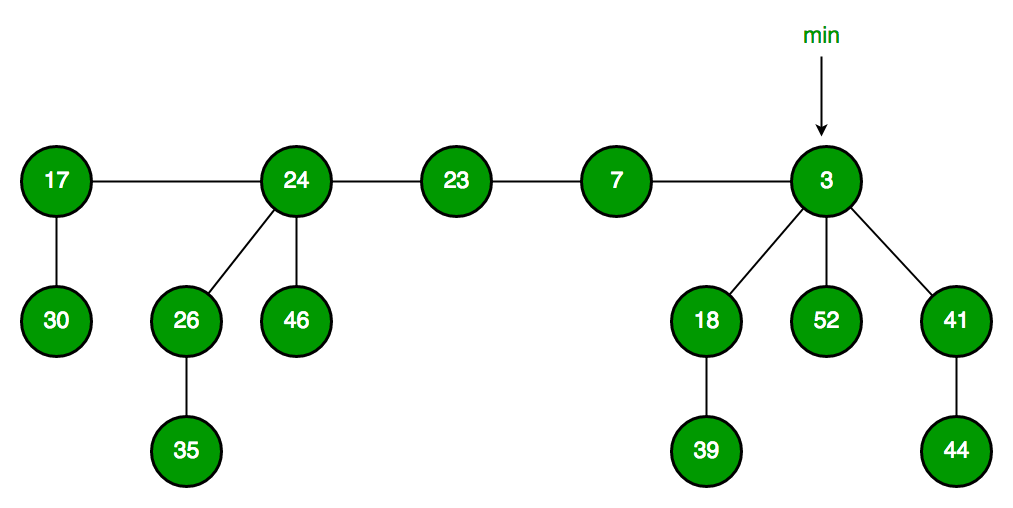
Fibonacci Heap maintains a pointer to minimum value (which is root of a tree). All tree roots are connected using circular doubly linked list, so all of them can be accessed using single ‘min’ pointer.
The main idea is to execute operations in “lazy” way. For example merge operation simply links two heaps, insert operation simply adds a new tree with single node. The operation extract minimum is the most complicated operation. It does delayed work of consolidating trees. This makes delete also complicated as delete first decreases key to minus infinite, then calls extract minimum.
Below are some interesting facts about Fibonacci Heap
- The reduced time complexity of Decrease-Key has importance in Dijkstra and Prim algorithms. With Binary Heap, time complexity of these algorithms is O(VLogV + ELogV). If Fibonacci Heap is used, then time complexity is improved to O(VLogV + E)
- Although Fibonacci Heap looks promising time complexity wise, it has been found slow in practice as hidden constants are high (Source Wiki).
- Fibonacci heap are mainly called so because Fibonacci numbers are used in the running time analysis. Also, every node in Fibonacci Heap has degree at most O(log n) and the size of a subtree rooted in a node of degree k is at least Fk+2, where Fk is the kth Fibonacci number.
Fibonacci Heap – Insertion and Union
Fibonacci Heap is a collection of trees with min-heap or max-heap property. In Fibonacci Heap, trees can have any shape even all trees can be single nodes (This is unlike Binomial Heap where every tree has to be a Binomial Tree). In this article, we will discuss Insertion and Union operation on Fibonacci Heap.
Insertion: To insert a node in a Fibonacci heap H, the following algorithm is followed:
Create a new node ‘x’.
Check whether heap H is empty or not.
If H is empty then:
Make x as the only node in the root list.
Set H(min) pointer to x.
Else:
Insert x into root list and update H(min).

Union: Union of two Fibonacci heaps H1 and H2 can be accomplished as follows:
Join root lists of Fibonacci heaps H1 and H2 and make a single Fibonacci heap H.
If H1(min) < H2(min) then:
H(min) = H1(min).
Else:
H(min) = H2(min).

Fibonacci Heap – Insertion and Union in C++
// C++ program to demonstrate building
// and inserting in a Fibonacci heap
#include <cstdlib>
#include <iostream>
#include <malloc.h>
using namespace std;
struct node {
node* parent;
node* child;
node* left;
node* right;
int key;
};
// Creating min pointer as "mini"
struct node* mini = NULL;
// Declare an integer for number of nodes in the heap
int no_of_nodes = 0;
// Function to insert a node in heap
void insertion(int val)
{
struct node* new_node = (struct node*)malloc(sizeof(struct node));
new_node->key = val;
new_node->parent = NULL;
new_node->child = NULL;
new_node->left = new_node;
new_node->right = new_node;
if (mini != NULL) {
(mini->left)->right = new_node;
new_node->right = mini;
new_node->left = mini->left;
mini->left = new_node;
if (new_node->key < mini->key)
mini = new_node;
}
else {
mini = new_node;
}
}
// Function to display the heap
void display(struct node* mini)
{
node* ptr = mini;
if (ptr == NULL)
cout << "The Heap is Empty" << endl;
else {
cout << "The root nodes of Heap are: " << endl;
do {
cout << ptr->key;
ptr = ptr->right;
if (ptr != mini) {
cout << "-->";
}
} while (ptr != mini && ptr->right != NULL);
cout << endl
<< "The heap has " << no_of_nodes << " nodes" << endl;
}
}
// Function to find min node in the heap
void find_min(struct node* mini)
{
cout << "min of heap is: " << mini->key << endl;
}
// Driver code
int main()
{
no_of_nodes = 7;
insertion(4);
insertion(3);
insertion(7);
insertion(5);
insertion(2);
insertion(1);
insertion(10);
display(mini);
find_min(mini);
return 0;
}
Fibonacci Heap – Deletion, Extract min and Decrease key
Extract_min():
We create a function for deleting the minimum node and setting the min pointer to the minimum value in the remaining heap. The following algorithm is followed:
Delete the min node.
Set head to the next min node and add all the trees of the deleted node in the root list.
Create an array of degree pointers of the size of the deleted node.
Set degree pointer to the current node.
Move to the next node.
If degrees are different then set degree pointer to next node.
If degrees are the same then join the Fibonacci trees by union operation.
Repeat steps 4 and 5 until the heap is completed.
Example:

Decrease_key():
To decrease the value of any element in the heap, we follow the following algorithm:
Decrease the value of the node ‘x’ to the new chosen value.
CASE 1) If min-heap property is not violated,
Update min pointer if necessary.
CASE 2) If min-heap property is violated and parent of ‘x’ is unmarked,
Cut off the link between ‘x’ and its parent.
Mark the parent of ‘x’.
Add tree rooted at ‘x’ to the root list and update min pointer if necessary.
CASE 3)If min-heap property is violated and parent of ‘x’ is marked,
Cut off the link between ‘x’ and its parent p[x].
Add ‘x’ to the root list, updating min pointer if necessary.
Cut off link between p[x] and p[p[x]].
Add p[x] to the root list, updating min pointer if necessary.
If p[p[x]] is unmarked, mark it.
Else, cut off p[p[x]] and repeat steps 4.2 to 4.5, taking p[p[x]] as ‘x’.
Example:

Deletion():
To delete any element in a Fibonacci heap, the following algorithm is followed:
Decrease the value of the node to be deleted ‘x’ to a minimum by Decrease_key() function.
By using min-heap property, heapify the heap containing ‘x’, bringing ‘x’ to the root list.
Apply Extract_min() algorithm to the Fibonacci heap.
Example:

Fibonacci Heap – Deletion, Extract min and Decrease key in C++
// C++ program to demonstrate Extract min, Deletion()
// and Decrease key() operations in a fibonacci heap
#include <cmath>
#include <cstdlib>
#include <iostream>
#include <malloc.h>
using namespace std;
// Creating a structure to represent a node in the heap
struct node {
node* parent; // Parent pointer
node* child; // Child pointer
node* left; // Pointer to the node on the left
node* right; // Pointer to the node on the right
int key; // Value of the node
int degree; // Degree of the node
char mark; // Black or white mark of the node
char c; // Flag for assisting in the Find node function
};
// Creating min pointer as "mini"
struct node* mini = NULL;
// Declare an integer for number of nodes in the heap
int no_of_nodes = 0;
// Function to insert a node in heap
void insertion(int val)
{
struct node* new_node = new node();
new_node->key = val;
new_node->degree = 0;
new_node->mark = 'W';
new_node->c = 'N';
new_node->parent = NULL;
new_node->child = NULL;
new_node->left = new_node;
new_node->right = new_node;
if (mini != NULL) {
(mini->left)->right = new_node;
new_node->right = mini;
new_node->left = mini->left;
mini->left = new_node;
if (new_node->key < mini->key)
mini = new_node;
}
else {
mini = new_node;
}
no_of_nodes++;
}
// Linking the heap nodes in parent child relationship
void Fibonnaci_link(struct node* ptr2, struct node* ptr1)
{
(ptr2->left)->right = ptr2->right;
(ptr2->right)->left = ptr2->left;
if (ptr1->right == ptr1)
mini = ptr1;
ptr2->left = ptr2;
ptr2->right = ptr2;
ptr2->parent = ptr1;
if (ptr1->child == NULL)
ptr1->child = ptr2;
ptr2->right = ptr1->child;
ptr2->left = (ptr1->child)->left;
((ptr1->child)->left)->right = ptr2;
(ptr1->child)->left = ptr2;
if (ptr2->key < (ptr1->child)->key)
ptr1->child = ptr2;
ptr1->degree++;
}
// Consolidating the heap
void Consolidate()
{
int temp1;
float temp2 = (log(no_of_nodes)) / (log(2));
int temp3 = temp2;
struct node* arr[temp3+1];
for (int i = 0; i <= temp3; i++)
arr[i] = NULL;
node* ptr1 = mini;
node* ptr2;
node* ptr3;
node* ptr4 = ptr1;
do {
ptr4 = ptr4->right;
temp1 = ptr1->degree;
while (arr[temp1] != NULL) {
ptr2 = arr[temp1];
if (ptr1->key > ptr2->key) {
ptr3 = ptr1;
ptr1 = ptr2;
ptr2 = ptr3;
}
if (ptr2 == mini)
mini = ptr1;
Fibonnaci_link(ptr2, ptr1);
if (ptr1->right == ptr1)
mini = ptr1;
arr[temp1] = NULL;
temp1++;
}
arr[temp1] = ptr1;
ptr1 = ptr1->right;
} while (ptr1 != mini);
mini = NULL;
for (int j = 0; j <= temp3; j++) {
if (arr[j] != NULL) {
arr[j]->left = arr[j];
arr[j]->right = arr[j];
if (mini != NULL) {
(mini->left)->right = arr[j];
arr[j]->right = mini;
arr[j]->left = mini->left;
mini->left = arr[j];
if (arr[j]->key < mini->key)
mini = arr[j];
}
else {
mini = arr[j];
}
if (mini == NULL)
mini = arr[j];
else if (arr[j]->key < mini->key)
mini = arr[j];
}
}
}
// Function to extract minimum node in the heap
void Extract_min()
{
if (mini == NULL)
cout << "The heap is empty" << endl;
else {
node* temp = mini;
node* pntr;
pntr = temp;
node* x = NULL;
if (temp->child != NULL) {
x = temp->child;
do {
pntr = x->right;
(mini->left)->right = x;
x->right = mini;
x->left = mini->left;
mini->left = x;
if (x->key < mini->key)
mini = x;
x->parent = NULL;
x = pntr;
} while (pntr != temp->child);
}
(temp->left)->right = temp->right;
(temp->right)->left = temp->left;
mini = temp->right;
if (temp == temp->right && temp->child == NULL)
mini = NULL;
else {
mini = temp->right;
Consolidate();
}
no_of_nodes--;
}
}
// Cutting a node in the heap to be placed in the root list
void Cut(struct node* found, struct node* temp)
{
if (found == found->right)
temp->child = NULL;
(found->left)->right = found->right;
(found->right)->left = found->left;
if (found == temp->child)
temp->child = found->right;
temp->degree = temp->degree - 1;
found->right = found;
found->left = found;
(mini->left)->right = found;
found->right = mini;
found->left = mini->left;
mini->left = found;
found->parent = NULL;
found->mark = 'B';
}
// Recursive cascade cutting function
void Cascase_cut(struct node* temp)
{
node* ptr5 = temp->parent;
if (ptr5 != NULL) {
if (temp->mark == 'W') {
temp->mark = 'B';
}
else {
Cut(temp, ptr5);
Cascase_cut(ptr5);
}
}
}
// Function to decrease the value of a node in the heap
void Decrease_key(struct node* found, int val)
{
if (mini == NULL)
cout << "The Heap is Empty" << endl;
if (found == NULL)
cout << "Node not found in the Heap" << endl;
found->key = val;
struct node* temp = found->parent;
if (temp != NULL && found->key < temp->key) {
Cut(found, temp);
Cascase_cut(temp);
}
if (found->key < mini->key)
mini = found;
}
// Function to find the given node
void Find(struct node* mini, int old_val, int val)
{
struct node* found = NULL;
node* temp5 = mini;
temp5->c = 'Y';
node* found_ptr = NULL;
if (temp5->key == old_val) {
found_ptr = temp5;
temp5->c = 'N';
found = found_ptr;
Decrease_key(found, val);
}
if (found_ptr == NULL) {
if (temp5->child != NULL)
Find(temp5->child, old_val, val);
if ((temp5->right)->c != 'Y')
Find(temp5->right, old_val, val);
}
temp5->c = 'N';
found = found_ptr;
}
// Deleting a node from the heap
void Deletion(int val)
{
if (mini == NULL)
cout << "The heap is empty" << endl;
else {
// Decreasing the value of the node to 0
Find(mini, val, 0);
// Calling Extract_min function to
// delete minimum value node, which is 0
Extract_min();
cout << "Key Deleted" << endl;
}
}
// Function to display the heap
void display()
{
node* ptr = mini;
if (ptr == NULL)
cout << "The Heap is Empty" << endl;
else {
cout << "The root nodes of Heap are: " << endl;
do {
cout << ptr->key;
ptr = ptr->right;
if (ptr != mini) {
cout << "-->";
}
} while (ptr != mini && ptr->right != NULL);
cout << endl
<< "The heap has " << no_of_nodes << " nodes" << endl
<< endl;
}
}
// Driver code
int main()
{
// We will create a heap and insert 3 nodes into it
cout << "Creating an initial heap" << endl;
insertion(5);
insertion(2);
insertion(8);
// Now we will display the root list of the heap
display();
// Now we will extract the minimum value node from the heap
cout << "Extracting min" << endl;
Extract_min();
display();
// Now we will decrease the value of node '8' to '7'
cout << "Decrease value of 8 to 7" << endl;
Find(mini, 8, 7);
display();
// Now we will delete the node '7'
cout << "Delete the node 7" << endl;
Deletion(7);
display();
return 0;
}
